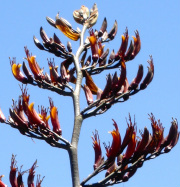
by Leonard Bell
In the middle years of last century considerable numbers of displaced people from Central and Eastern Europe found their way to New Zealand, escaping Nazism before World War ll, or the Communist regimes established after the War.
A significant proportion of these were Jewish. Some were also highly educated intellectuals, with a strong interest in the Arts. What they found in New Zealand was a relatively tiny population of some two million people, with a proportionately smaller number still who shared their cultural interests. To some, at first, New Zealand seemed to be strange and unwelcoming; though most settled comfortably enough, finding others, emigrés and locals, who shared their interests, and adjusting their creativity to the new conditions. Some, perhaps not artists themselves, became patrons, their support being of very considerable significance to the development of the arts in a number of fields.
There is an underlying suggestion in this book, reinforced mostly by quotation of the views of contemporary commentators, that New Zealand was, before the timely influence of the emigrés, a bland cultural backwater. Phrases quoted include: ‘methodical mediocrity’, ‘neither a country nor a culture, it’s a branch of the Salvation Army’, ‘half as big as Boston cemetery and twice as dead’, ‘scrubby vulgarity…third-ratedness and complacency’, ‘a bleak, inarticulate, materialistic society.’ The author himself iterates the common shibboleth that New Zealand society had (and has) a strong (by implication, a stronger than most) anti-intellectual character, having much greater pride in its ‘No. 8 wire’ mentality than in any cultural achievements.
But was this really so? The numbers were small, yes – but those skilled in the use of No. 8 wire were sometimes the same people who enthusiastically supported the local Little Theatre, used the local library, listened to learned people on radio, and perhaps even scribbled their own stories or poems, shaped their own pottery or composed their own music, and so became contributors to the nation’s artistic heritage from their bases not only in the cities, but also in the smaller towns and rural communities. New Zealand was then, as now, a well-educated society with book-reading habits that placed them amongst the world’s most literate, and a lively interest in what was going on elsewhere, even in the midst of the economic depression, and of war. Of course there was a strong element of anti-intellectualism, but the same can be said of any other society, at any other time.
During those mid-century years, the New Zealand arts scene was, in fact, one of exceptional creativity, as is revealed in, for example, Peter Simpson’s Bloomsbury South, or Terry Sturm’s biography of Allen Curnow. It was a time when the artists of the nation were moving away from the ‘imitative’ patterns of the colonial period and towards an art both more genuinely home-grown and yet more universal.
There was a pre-existing and still dynamic tradition of Māori art, too. The book describes how the newcomers were able to look at this without the stifling historical baggage from the colonial period, some contributing significantly to a fresh appreciation of Māori art and Māori society.
Bell convincingly demonstrates how the new arrivals made contributions, sometimes seminally important contributions, to all this activity, especially in the fields of photography, ceramics and architecture. A few of the names he presents to us are familiar, others less so; but either way, we can be grateful that he has reminded us, or made us aware, of them.
A further feature of the book is the examination of the experiences of those who were, or who felt themselves to be, ‘outsiders’ (both newcomers and New Zealand born), and how such feelings affected their creative processes. By discussing these and other issues, the author encourages, even provokes, the reader into a deeper assessment of New Zealand cultural activities in those chaotic and difficult yet astonishingly productive years before, during and after the Second World War.
The view of the New Zealand art scene presented here is largely an urban one, and the style of presentation is urbane. This is a visually and intellectually stimulating book, and Bell has skilfully integrated the text with well-chosen illustrations.
Above all, it deals with themes of abiding interest and importance. As the author asserts, ‘[we should see] the arts and humanities as essential necessities for a good and truly civilised society.’
Author: Leonard Bell
Publisher: Auckland University Press
ISBN: 9781869408732
RRP: $ 75.00
Available: Bookshops

 RSS Feed
RSS Feed
